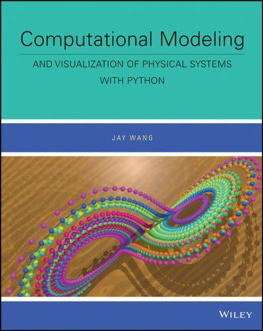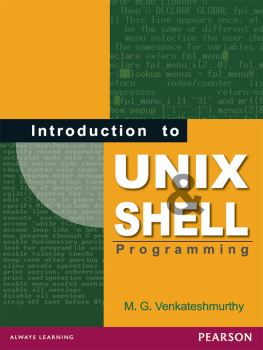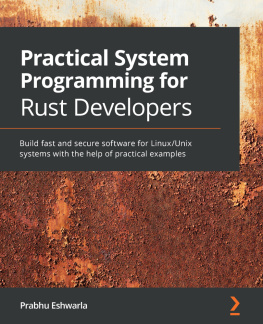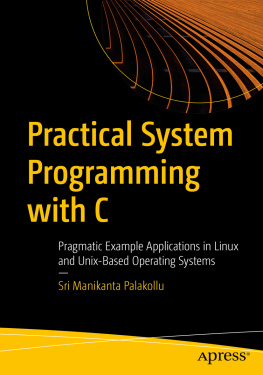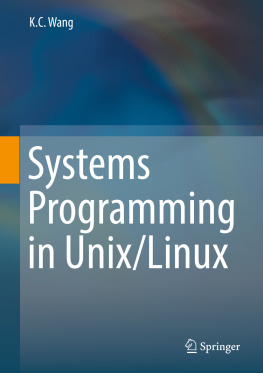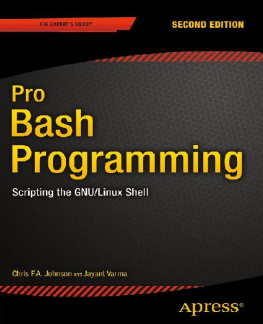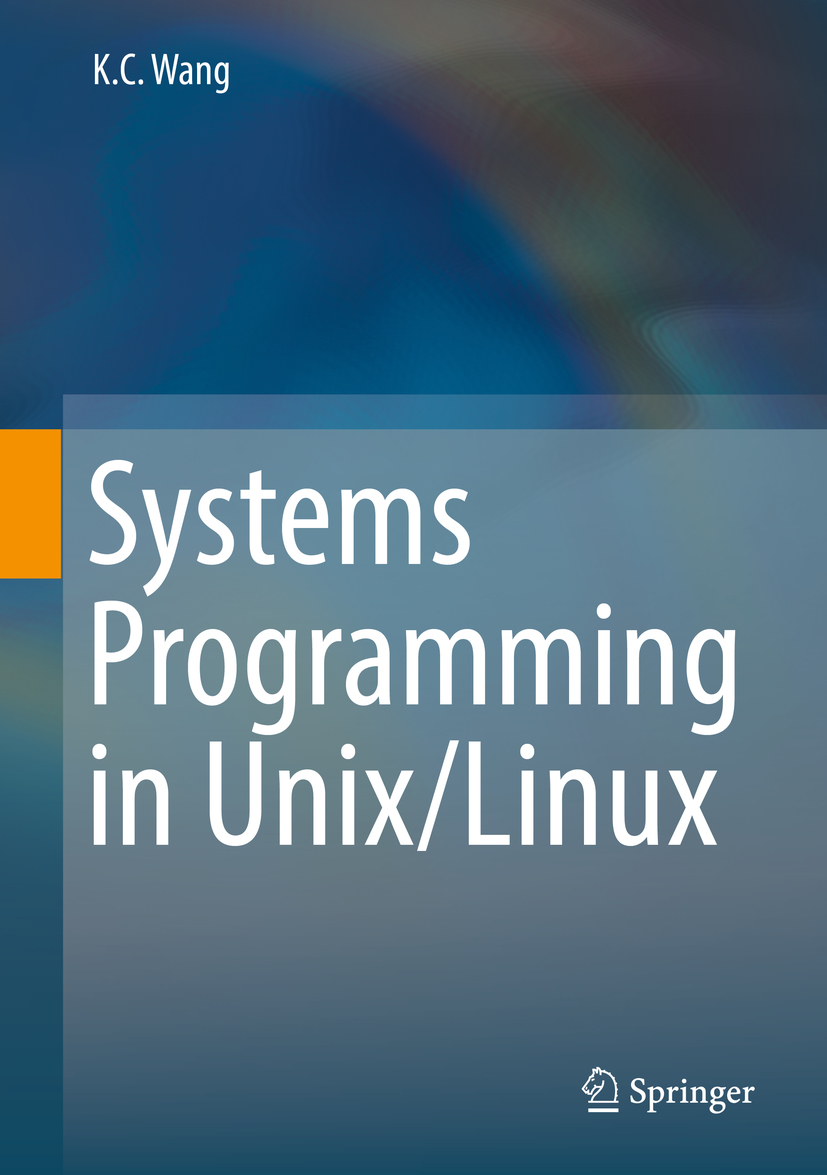K. C. Wang
Systems Programming in Unix/Linux
K. C. Wang
School of Electrical Engineering, Washington State University, Pullman, WA, USA
ISBN 978-3-319-92428-1 e-ISBN 978-3-319-92429-8
https://doi.org/10.1007/978-3-319-92429-8
Library of Congress Control Number: 2018945425
Springer Nature Switzerland AG 2018
This work is subject to copyright. All rights are reserved by the Publisher, whether the whole or part of the material is concerned, specifically the rights of translation, reprinting, reuse of illustrations, recitation, broadcasting, reproduction on microfilms or in any other physical way, and transmission or information storage and retrieval, electronic adaptation, computer software, or by similar or dissimilar methodology now known or hereafter developed.
The use of general descriptive names, registered names, trademarks, service marks, etc. in this publication does not imply, even in the absence of a specific statement, that such names are exempt from the relevant protective laws and regulations and therefore free for general use.
The publisher, the authors, and the editors are safe to assume that the advice and information in this book are believed to be true and accurate at the date of publication. Neither the publisher nor the authors or the editors give a warranty, express or implied, with respect to the material contained herein or for any errors or omissions that may have been made. The publisher remains neutral with regard to jurisdictional claims in published maps and institutional affiliations.
This Springer imprint is published by the registered company Springer Nature Switzerland AG
The registered company address is: Gewerbestrasse 11, 6330 Cham, Switzerland
Dedicated to
Cindy
Preface
Systems programming is an indispensable part of Computer Science and Computer Engineering education. System programming courses in Computer Science/Engineering curriculums play two important roles. First, it provides students with a wide range of knowledge about computer system software and advanced programming skills, allowing them to interface with operating system kernel, perform file operations and network programming, and make efficient use of system resources to develop application programs. Second, it prepares students with needed background to pursue advanced studies in Computer Science/Engineering, such as operating systems, embedded systems, database systems, data mining, artificial intelligence, computer networks, and distributed and parallel computing. Due to its importance, systems programming in Unix/Linux has been a popular subject matter in CS/CE education and also for self-study by advanced programmers. As a result, there are a tremendous number of books and online articles in this area. Despite these, I still find it difficult to choose a suitable book for the Systems Programming course I teach at WSU. For many years, I had to use my own class notes and programming assignments in the course. After careful thinking, I have decided to put together the materials into a book form.
The purpose of this book is to provide a suitable platform for teaching and learning the theory and practice of systems programming. Unlike most other books, this book covers systems programming topics in greater depth and it stresses programming practice. It uses a series of programming projects to let students apply their acquired knowledge and programming skills to develop practical and useful programs. The book is intended as a textbook in technical-oriented systems programming courses. It contains detailed example programs with complete source code, making it suitable for self-study also.
Undertaking this book project has proved to be another very demanding and time-consuming endeavor. While preparing the manuscripts for publication, I have been blessed with the encouragement and help from many people. I would like to take this opportunity to thank all of them. I want to especially thank Yan Zhang for his help in preparing figures for the book and proof-reading the manuscript.
Special thanks go to Cindy for her continuing support and inspirations, which have made this book possible. Above all, I would like to thank my family for bearing with me with endless excuses of being busy all the time.
Sample solutions of programming projects in the book are available for download at http://wang.eecs.wsu.edu/~kcw . For source code, please contact the author by email.
K. C. Wang
Pullman, WA, USA
April, 2018
About the Author
K. C. Wang
received the BSEE degree from National Taiwan University in 1960 and the PhD degree in Electrical Engineering from Northwestern University, Evanston, IL, in 1965. He is currently a professor in the School of Electrical Engineering and Computer Science at Washington State University. His academic interests are in operating systems, distributed systems, and parallel computing.
Springer International Publishing AG, part of Springer Nature 2018
K.C. Wang Systems Programming in Unix/Linux https://doi.org/10.1007/978-3-319-92429-8_1
1. Introduction
K. C. Wang
(1)
School of Electrical Engineering, Washington State University, Pullman, WA, USA
Abstract
This chapter presents an introduction to the book. It describes the books scope, intended audience and its suitability as a textbook in Computer Science/Engineering curriculums. It presents a brief history of Unix, which includes early versions of Unix at Bell Labs, AT&T System V and other developments of Unix, such as BSD, HP UX, IBM AIX and Sun/Solaris Unix. It describes the development of Linux and various Linux distributions, which include Debian, Ubuntu, Mint, Red Hat and Slackware. It lists both the hardware platforms and virtual machines for Linux. It shows how to install Ubuntu Linux to both VirtualBox and Vmware virtual machines inside the Microsoft Windows. It explains the startup sequence of Linux, from booting the Linux kernel to user login and command execution. It describes the Unix/Linux file system organization, file types and commonly used Unix/Linux commands. Lastly, it describes system administration tasks for users to manage and maintain their Linux systems.
1.1 About This Book
This book is about systems programming in the Unix/Linux (Thompson and Ritchie ) environment. It covers all the essential components of Unix/Linux, which include process management, concurrent programming, timer and time service, file systems, network programming and MySQL database system. In addition to covering the functionalities of Unix/Linux, it stresses on programming practice. It uses programming exercises and realistic programming projects to allow students to practice systems programming with hands-on experiences.
1.2 Roles of Systems Programming
Systems programming is an indispensable part of Computer Science and Computer Engineering education. System programming courses in Computer Science/Engineering curriculums serve two main purposes. First, it provides students with a wide range of knowledge about computer system software and advanced programming skills, allowing them to interface with operating system kernel, make efficient use of system resources to develop application software. Second, it prepares students with the needed background to pursue advanced studies in Computer Science/Engineering, such as operating systems, embedded systems, database systems, data mining, artificial intelligence, computer networks, network security, distributed and parallel computing.


